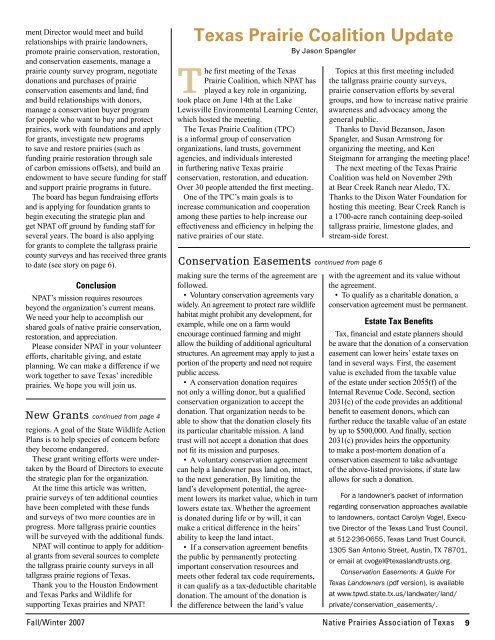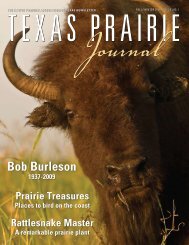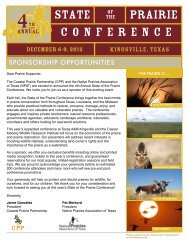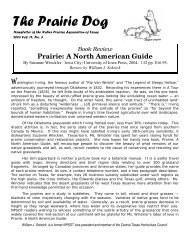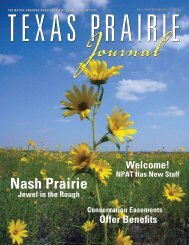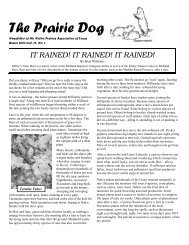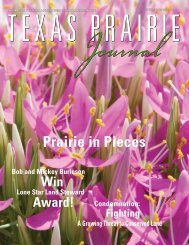2007 Fall/Winter issue - Native Prairies Association of Texas
2007 Fall/Winter issue - Native Prairies Association of Texas
2007 Fall/Winter issue - Native Prairies Association of Texas
Create successful ePaper yourself
Turn your PDF publications into a flip-book with our unique Google optimized e-Paper software.
ment Director would meet and build<br />
relationships with prairie landowners,<br />
promote prairie conservation, restoration,<br />
and conservation easements, manage a<br />
prairie county survey program, negotiate<br />
donations and purchases <strong>of</strong> prairie<br />
conservation easements and land, find<br />
and build relationships with donors,<br />
manage a conservation buyer program<br />
for people who want to buy and protect<br />
prairies, work with foundations and apply<br />
for grants, investigate new programs<br />
to save and restore prairies (such as<br />
funding prairie restoration through sale<br />
<strong>of</strong> carbon emissions <strong>of</strong>fsets), and build an<br />
endowment to have secure funding for staff<br />
and support prairie programs in future.<br />
The board has begun fund raising efforts<br />
and is applying for foundation grants to<br />
begin executing the strategic plan and<br />
get NPAT <strong>of</strong>f ground by funding staff for<br />
several years. The board is also applying<br />
for grants to complete the tallgrass prairie<br />
county surveys and has received three grants<br />
to date (see story on page 6).<br />
Conclusion<br />
NPAT’s mission requires resources<br />
beyond the organization’s current means.<br />
We need your help to accomp lish our<br />
shared goals <strong>of</strong> native prairie conservation,<br />
restoration, and appreciation.<br />
Please consider NPAT in your volunteer<br />
efforts, charitable giving, and estate<br />
planning. We can make a difference if we<br />
work together to save <strong>Texas</strong>’ incredible<br />
prairies. We hope you will join us.<br />
New Grants continued from page 4<br />
regions. A goal <strong>of</strong> the State Wildlife Action<br />
Plans is to help species <strong>of</strong> concern before<br />
they become endangered.<br />
These grant writing efforts were undertaken<br />
by the Board <strong>of</strong> Directors to execute<br />
the strategic plan for the organization.<br />
At the time this article was written,<br />
prairie surveys <strong>of</strong> ten additional counties<br />
have been completed with these funds<br />
and surveys <strong>of</strong> two more counties are in<br />
progress. More tallgrass prairie counties<br />
will be surveyed with the additional funds.<br />
NPAT will continue to apply for additional<br />
grants from several sources to complete<br />
the tallgrass prairie county surveys in all<br />
tallgrass prairie regions <strong>of</strong> <strong>Texas</strong>.<br />
Thank you to the Houston Endowment<br />
and <strong>Texas</strong> Parks and Wildlife for<br />
supporting <strong>Texas</strong> prairies and NPAT!<br />
<strong>Texas</strong> Prairie Coalition Update<br />
By Jason Spangler<br />
The first meeting <strong>of</strong> the <strong>Texas</strong><br />
Prairie Coalition, which NPAT has<br />
played a key role in organizing,<br />
took place on June 14th at the Lake<br />
Lewisville Environmental Learning Center,<br />
which hosted the meeting.<br />
The <strong>Texas</strong> Prairie Coalition (TPC)<br />
is a informal group <strong>of</strong> conservation<br />
organizations, land trusts, government<br />
agencies, and individuals interested<br />
in furthering native <strong>Texas</strong> prairie<br />
conservation, restoration, and education.<br />
Over 30 people attended the first meeting.<br />
One <strong>of</strong> the TPC’s main goals is to<br />
increase communication and cooperation<br />
among these parties to help increase our<br />
effectiveness and efficiency in helping the<br />
native prairies <strong>of</strong> our state.<br />
Conservation Easements continued from page 6<br />
making sure the terms <strong>of</strong> the agreement are<br />
followed.<br />
• Voluntary conservation agreements vary<br />
widely. An agreement to protect rare wildlife<br />
habitat might prohibit any development, for<br />
example, while one on a farm would<br />
encourage continued farming and might<br />
allow the building <strong>of</strong> additional agricultural<br />
structures. An agree ment may apply to just a<br />
portion <strong>of</strong> the property and need not require<br />
public access.<br />
• A conservation donation requires<br />
not only a willing donor, but a qualified<br />
conservation organization to accept the<br />
donation. That organization needs to be<br />
able to show that the donation closely fits<br />
its particular charitable mission. A land<br />
trust will not accept a donation that does<br />
not fit its mission and purposes.<br />
• A voluntary conservation agreement<br />
can help a landowner pass land on, intact,<br />
to the next generation. By limiting the<br />
land’s development potential, the agreement<br />
lowers its market value, which in turn<br />
lowers estate tax. Whether the agreement<br />
is donated during life or by will, it can<br />
make a critical difference in the heirs’<br />
ability to keep the land intact.<br />
• If a conservation agreement benefits<br />
the public by permanently protecting<br />
important conservation resources and<br />
meets other federal tax code requirements,<br />
it can qualify as a tax-deductible charitable<br />
donation. The amount <strong>of</strong> the donation is<br />
the difference between the land’s value<br />
Topics at this first meeting included<br />
the tallgrass prairie county surveys,<br />
prairie conservation efforts by several<br />
groups, and how to increase native prairie<br />
awareness and advocacy among the<br />
general public.<br />
Thanks to David Bezanson, Jason<br />
Spangler, and Susan Armstrong for<br />
organizing the meeting, and Ken<br />
Steigmann for arranging the meeting place!<br />
The next meeting <strong>of</strong> the <strong>Texas</strong> Prairie<br />
Coalition was held on November 29th<br />
at Bear Creek Ranch near Aledo, TX.<br />
Thanks to the Dixon Water Foundation for<br />
hosting this meeting. Bear Creek Ranch is<br />
a 1700-acre ranch containing deep-soiled<br />
tallgrass prairie, limestone glades, and<br />
stream-side forest.<br />
with the agreement and its value without<br />
the agreement.<br />
• To qualify as a charitable donation, a<br />
conservation agreement must be permanent.<br />
Estate Tax Benefits<br />
Tax, financial and estate planners should<br />
be aware that the donation <strong>of</strong> a conservation<br />
easement can lower heirs’ estate taxes on<br />
land in several ways. First, the easement<br />
value is excluded from the taxable value<br />
<strong>of</strong> the estate under section 2055(f) <strong>of</strong> the<br />
Internal Revenue Code. Second, section<br />
2031(c) <strong>of</strong> the code provides an additional<br />
benefit to easement donors, which can<br />
further reduce the taxable value <strong>of</strong> an estate<br />
by up to $500,000. And finally, section<br />
2031(c) provides heirs the opportunity<br />
to make a post-mortem donation <strong>of</strong> a<br />
conservation easement to take advantage<br />
<strong>of</strong> the above-listed provisions, if state law<br />
allows for such a donation.<br />
For a landowner’s packet <strong>of</strong> informa tion<br />
regarding conservation approaches available<br />
to landowners, contact Carolyn Vogel, Executive<br />
Director <strong>of</strong> the <strong>Texas</strong> Land Trust Council,<br />
at 512-236-0655, <strong>Texas</strong> Land Trust Council,<br />
1305 San Antonio Street, Austin, TX 78701,<br />
or email at cvogel@texaslandtrusts.org.<br />
Conservation Ease ments: A Guide For<br />
<strong>Texas</strong> Landowners (pdf version), is available<br />
at www.tpwd.state.tx.us/landwater/land/<br />
private/conservation_easements/.<br />
<strong>Fall</strong>/<strong>Winter</strong> <strong>2007</strong><br />
native <strong>Prairies</strong> <strong>Association</strong> <strong>of</strong> <strong>Texas</strong><br />
9


